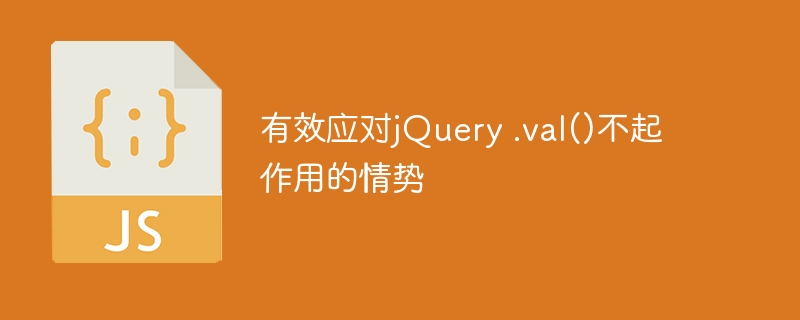Home >Web Front-end >JS Tutorial >Effectively deal with situations where jQuery .val() doesn't work
Effectively deal with situations where jQuery .val() doesn't work
- WBOYWBOYWBOYWBOYWBOYWBOYWBOYWBOYWBOYWBOYWBOYWBOYWBOriginal
- 2024-02-20 21:36:04583browse

Title: Methods and code examples to solve the problem of jQuery .val() not working
In front-end development, jQuery is often used to operate page elements. Among them, getting or setting the value of a form element is one of the common operations. Usually, we use jQuery's .val() method to operate on form element values. However, sometimes you encounter situations where jQuery .val() does not work, which may cause some problems. This article will explain how to effectively deal with jQuery .val() not working, while providing specific code examples to help solve this problem.
1. Confirm whether the selector is correct
When using jQuery to operate page elements, you must first confirm whether the selector is correct. If the selector selects an element that does not exist, jQuery operations will not take effect, including the .val() method. Therefore, selectors need to be carefully checked for accuracy.
// 错误的选择器示例
$('.wrong-selector').val();
// 正确的选择器示例
$('.correct-selector').val();2. Confirm whether the element exists in the DOM
Another common problem is whether the element exists in the DOM. If the element is dynamically generated or added to the page through asynchronous loading, it may cause the .val() method to not work. In this case, you can use event delegation to operate the element.
// 动态生成元素的示例
$(document).on('click', '.dynamic-element', function() {
$(this).val('Dynamic Value');
});3. Confirm the page loading timing
Sometimes the jQuery code is executed before the page is loaded, resulting in the element not being fully loaded, so the .val() method does not work. In order to solve this problem, you can place the code in $(document).ready() and make sure that all page elements are loaded before executing it.
$(document).ready(function() {
$('.element').val('Initial Value');
});4. Check whether there are other influences
Finally, you also need to check whether there are other factors that affect the effect of the .val() method, such as style issues, other JavaScript codes, etc. Make sure that nothing else interferes with the normal operation of the .val() method.
To sum up, to solve the problem of jQuery .val() not working, you must first confirm whether the selector is correct, whether the element exists in the DOM, whether the page loading time is correct, and whether there are other effects . By carefully troubleshooting possible problems, you can effectively solve the situation where the .val() method does not work and ensure the normal operation of the code.
The above is the detailed content of Effectively deal with situations where jQuery .val() doesn't work. For more information, please follow other related articles on the PHP Chinese website!

